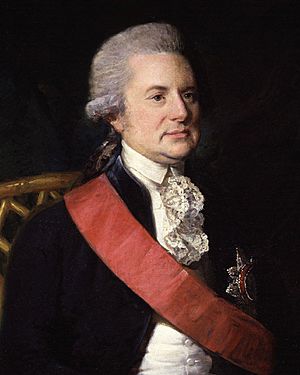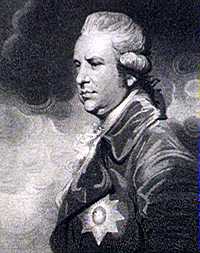George Macartney, 1st Earl Macartney facts for kids
- George Macartney should not be confused with Sir George Macartney, a later British statesman.
Quick facts for kids
The Earl Macartney
KB PC (Ire)
|
|
|---|---|
 |
|
| Governor of Grenada | |
| In office 1776–1779 |
|
| Monarch | George III |
| Preceded by | Sir William Young |
| Succeeded by | Jean-François, comte de Durat |
| Governor of Madras | |
| In office 22 June 1781 – 14 June 1785 |
|
| Monarch | George III |
| Preceded by | Sir Thomas Rumbold |
| Succeeded by | Sir Archibald Campbell |
| Governor of the Cape Colony | |
| In office 1797–1798 |
|
| Monarch | George III |
| Preceded by | Abraham Josias Sluysken |
| Succeeded by | Francis Dundas |
| Personal details | |
| Born | 14 May 1737 Loughguile, County Antrim, Ireland |
| Died | 31 May 1806 (aged 69) Chiswick, Middlesex, England |
| Alma mater | Trinity College Dublin |
George Macartney, 1st Earl Macartney (born May 14, 1737 – died May 31, 1806) was an important Anglo-Irish leader. He worked as a statesman, a colonial administrator, and a diplomat. He served as the governor of Grenada, Madras (in India), and the British-controlled Cape Colony (in South Africa).
Macartney is known for a famous quote after Britain won the Seven Years' War. He said Britain now controlled "a vast Empire, on which the sun never sets." This meant the British Empire was so big that the sun was always shining on some part of it.
Contents
Early Life and Career
George Macartney was born in 1737. He was the only son of George Macartney and Elizabeth Winder. His family came from Scotland but had lived in Ireland for a long time. They settled in a place called Lissanoure in County Antrim, Ireland, where George was born.
He went to Trinity College Dublin and finished his studies in 1759. After that, he studied law in London. A powerful person named Lord Holland helped him start his career.
In 1764, Macartney became a special ambassador to Russia. He successfully made an alliance, or agreement, between Great Britain and Russia with Catherine the Great.
Later, in 1768, he became a Member of Parliament in Ireland. He also worked as the Chief Secretary for Ireland, a very important role. After leaving this job, he was made a knight.
In 1775, he became the governor of the British West Indies. The next year, in 1776, he was given the title Baron Macartney. From 1780 to 1781, he was also a member of the British Parliament.
Governor of Grenada
Macartney was the governor of Grenada from 1776 to 1779. Grenada is an island in the Caribbean.
In July 1779, the French navy attacked the island. They were led by the Comte d'Estaing.
Macartney's forces lost control of Hospital Hill. This was a key defense spot overlooking the capital, St. George's. Because of this, Macartney decided to surrender. He was then taken as a prisoner to France.
Governor of Madras
Macartney served as the governor of Madras from 1781 to 1785. Madras is now known as Chennai in India.
During his time as governor, he started to fix and strengthen the walls of Fort St. George. This fort had been attacked before. The work was finished in 1783. Many new buildings and barracks were also built inside the fort during this period.
It was also during this time that the idea of a police force for Madras came up. A British resident named Stephen Popham suggested a plan to Macartney. He wanted a regular police force and better drainage systems for the city.
Popham also suggested naming and lighting streets. He wanted to record births and deaths and control who could sell alcohol. A Board of Police was later created to help manage these things.
Macartney also helped negotiate the Treaty of Mangalore. This treaty ended the Second Anglo-Mysore War in 1784. Macartney was offered the top job in British India, but he turned it down. He returned to Britain in 1786.
Ambassador to China
In 1792, George Macartney was given the title Earl Macartney. He was then chosen to be the first British ambassador to Qing China. Other attempts to send ambassadors had failed.
He led the Macartney Embassy to Beijing in 1792. A large British group traveled with him on a warship called HMS Lion. The main goal of the embassy was to open up trade with China.
The mission did not succeed in getting trade agreements. However, it did achieve other things. For example, the British learned a lot about the strength of the Chinese empire.
Many people believe the mission failed because Macartney refused to kowtow. This was a traditional Chinese bow of respect. But it's more likely that China was used to other countries showing them great respect. European countries, however, treated all states as equals.
So, Macartney was trying to negotiate as an equal, like in Europe. But the Qianlong Emperor of China was used to a different way of doing things. He saw China as the most important country.
After the embassy, the Qianlong Emperor sent a letter to King George III. He explained why he refused the British requests. This embassy was important because it was a missed chance for China to work better with Western countries. This failure caused problems for China later on.
The old trade rules, known as the Thirteen Factories, stayed in place. The embassy returned to Britain in 1794 without any new agreements. But the mission was still useful because it brought back detailed information.
Sir George Leonard Staunton wrote the official report of the trip. This report used notes from Lord Macartney and Captain Sir Erasmus Gower. Joseph Banks, a famous scientist, helped with the illustrations for the report.
Macartney had hoped to visit Japan after China. But when he returned to Canton, he heard that war had started with France. This meant his ships were in danger. So, he had to cancel his trip to Japan.
Later Life
In 1795, Macartney returned from a secret mission to Italy. He was then given a British noble title, Baron Macartney. In late 1796, he became the governor of the new Cape Colony in South Africa.
He stayed there until his health made him resign in November 1798. He died in Chiswick, England, on May 31, 1806. He had no children, so his title ended.
After his wife, Lady Jane Stuart, died, his property went to his niece. Her son then took the Macartney name.
See also
- Isaac Titsingh, another ambassador who visited the Qianlong Emperor
- William Pitt Amherst, 1st Earl Amherst
- Andreas Everardus van Braam Houckgeest
- Halliday Macartney – a relative who worked in China
Images for kids



